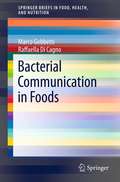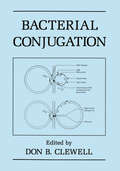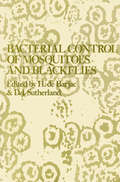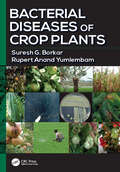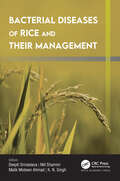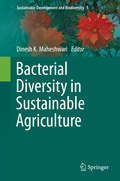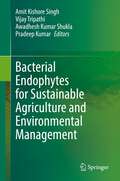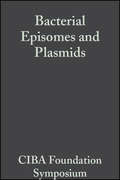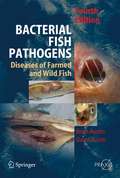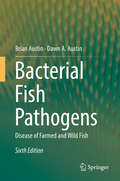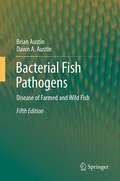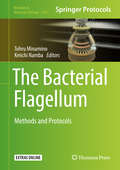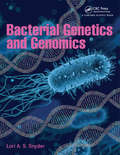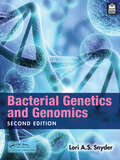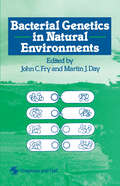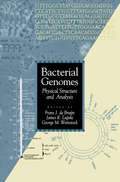- Table View
- List View
Bacterial Circadian Programs
by Jayna L. Ditty Shannon R. Mackey Carl H. JohnsonSince the discovery of circadian rhythms in cyanobacteria in the late 1980s, the field has exploded with new information. The cyanobacterial model system for studying circadian rhythms, "Synechococcus elongatus", has allowed a detailed genetic dissection of the bacterial clock due to the methods currently available in molecular, structural, and evolutionary biology. This book addresses multiple aspects of bacterial circadian programs: the history and background of the cyanobacteria and circadian rhythms in microorganisms, the molecular basis, structure, and evolution of the circadian clock, entrainment of the oscillator with the environment and the control of downstream processes by the clock, the demonstration of adaptive significance and the prokaryotic clock’s remarkable stability, and mathematical and synthetic oscillator models for clock function. Experts in the field provide a timely and comprehensive review and a stepping-stone for future work on this amazing group of microorganisms and timing.
Bacterial Communication in Foods (SpringerBriefs in Food, Health, and Nutrition)
by Marco Gobbetti Raffaella Di CagnoIt is generally assumed that microorganisms synthesize, release, detect and respond to small signaling hormone-like molecules. These molecules are used for a process termed “quorum sensing” (QS), a phenomenon that enables bacteria to sense when the minimal number of cells, or “quorum,” is achieved for a concerted response to be initiated. Words such as “language” and “behavior” are frequently used to depict QS in the literature. More simply put, language and cross-talk between bacteria, and between bacteria and animal or plant hosts, determines the behavior (e.g., beneficial or pathogenic effects) of bacteria. Currently, the major concern is to understand and decode this language. Overall, bacterial cross-talk was mainly studied on environmental, plant, and human pathogenic bacteria. Few studies considered food-related lactic acid bacteria. The cross-talk between bacteria influences the behavior and, in turn, the environmental adaptation and phenotypes. Therefore, it is understood that bacterial cross-talk has important applicative repercussions. The language spoken between bacteria populating the same food ecosystem may condition the phenotypic traits of starter lactic acid bacteria and, consequently, their performance. This Brief aims to define the basis of cell-to-cell signalling in food fermentation and will highlight: (i) microbiology, nutritional, chemical and functional aspects; (ii) functional properties due to microbial adaptation to the gastrointestinal tract; (iii) principal phenotypes under control of QS circuitries; (iv) quorum quenching. This Brief will be the first reference on this topic and it will highlight the main results for a more productive industrial application. Draft content 1. Signals of food related Gram-negative and Gram-positive bacteria The chapter will describe the different signaling languages used by Gram-negative bacteria (N-acyl-L-homoserine lactones) and Gram-positive bacteria (based on the synthesis of post-translationally modified peptides) and the universal chemical lexicon, shared by both Gram-positive and -negative bacteria (autoinducer-2 through the activity of the LuxS enzyme). 2. Phenotypes related to quorum sensing The chapter will describe the bacterial phenotypes, such as virulence, biofilm maturation, bacteriocin synthesis, and secondary metabolite production under control of QS circuitries. 3. Cell-to-cell signalling in fermented food: sourdough The chapter will describe the language spoken between bacteria populating the same food ecosystem (sourdough) and will provide an overview of the conditioned phenotypic traits of starter lactic acid bacteria and, consequently, their performance. 4. Cell-to-cell signalling in fermented food: yoghurt The chapter will describe the language spoken between bacteria populating the same food ecosystem (yoghurt) and will provide an overview of the conditioned phenotypic traits of starter lactic acid bacteria and, consequently, their performance. 5. Probiotic message at the intra-, inter-species and inter-kingdom level The chapter will describe the mechanisms that regulate the interaction between microorganism and host, and the capacity of the microorganism to adapt to environment. Particular reference will also be made to: (i) pathogen inhibition and restoration of microbial homeostasis through microbe-microbe interactions; (ii) enhancement of epithelial barrier function; and (iii) modulation of immune responses. 6. New Perspectives of quorum sensing This chapter will provide an overview of the future perspective regarding quorum sensing, showing that bacterial cross-talk may have important applicative repercussions. It will highlight the interference on the language of QS, which is defined as quorum quenching (QQ). Increasing translation of the bacterial cross-talk has shown that in some environmental circumstances, quenching of the language may occur.
Bacterial Conjugation
by D. B. ClewellBacterial plasmids originating in a wide range of genera are being studied from a variety of perspectives in hundreds of laboratories around the globe. These elements are well known for carrying "special" genes that confer important survival properties, frequently neces sary under atypical conditions. Classic examples of plasmid-borne genes are those provid ing bacterial resistance to toxic substances such as antibiotics, metal ions, and bacte riophage. Often included are those determining bacteriocins, which may give the bacterium an advantage in a highly competitive environment. Genes offering metabolic alternatives to the cell under nutritionally stressed conditions are also commonly found on plasmids, as are determinants important to colonization and pathogenesis. It is likely that in many, if not most, cases plasmids and their passenger determinants represent DNA acquired recently by their bacterial hosts, and it is the characteristic mobility of these elements that enables their efficient establishment in new bacterial cells by the process known as conjugation. Whereas many plasmids are fully capable of promoting their own conjugal transfer, others move only with help from coresident elements. The ability of a plasmid to establish itself in a variety of different species is com mon, and recent studies have shown that transfer can in some cases occur from bacterial cells to eukaryotes such as yeast.
Bacterial Control of Mosquitoes & Black Flies: Biochemistry, Genetics & Applications of Bacillus thuringiensis israelensis and Bacillus sphaericus
by Huguette De Barjac Donald J. SutherlandMosquitoes and black flies are a constant threat to health and comfort, yet the modern chemical pesticides used to control them have cre ated serious ecological problems. Populations of resistant mosquitoes and black flies have evolved, beneficial insects and natural predators have been destroyed, and environmental pollution has increased worldwide. Therefore, scientists have energetically sought new, environmentally safe technologies to combat mosquitoes and black flies and the diseases they carry. Among the most effective alternative means of controlling these pests are the highly spe cific microbial agents derived from Bacillus tburingiensis or Bacillus spbaericus. The microbial control of mosquitoes and black flies is a very important, rapidly developing area of science. Entomologists and microbiologists have already achieved spectacular successes using B. tburingiensis and B. spbaericus against these pests. Recent discoveries of new bacterial isolates specific to new hosts and recent genetic improvements in these isolates have created the potential for wide-scale use of these biological control agents. Efficient microbial control of mosquitoes and black flies can now be achieved, but a proper knowledge of factors relating to the safe and effective use of these biological control agents is necessary. The efficacy of B. tburingiensis and B. spbaericus is influenced by the inherent differential tol erance of the target mosquitoes or black flies, by the formulation technology and application of these agents, and by environmental factors, especially sun light and temperature.
Bacterial Degradation of Organic and Inorganic Materials
by Marziale Milani Roberta Curia Natalia Vladimirovna Shevlyagina Francesco TattiBacterial Diarrheal Diseases (New Perspectives in Clinical Microbiology #9)
by Y. Takeda T. MiwataniBacterial Diseases of Crop Plants
by Suresh G. Borkar Rupert Anand YumlembamFood and agriculture is an important component in the development and survival of civilizations. Around half of the world’s population and their economies are influenced by agricultural farm production. Plant diseases take as much as a 30 percent toll of the crop harvest if not managed properly and efficiently. Bacterial diseases of crop plants are important in plant disease scenarios worldwide and are observed on all kinds of cultivated and commercial value plants including cereals, pulses, oilseeds, fruits, vegetables, cash crops, plantation crops, spices, ornamentals and flowering plant, forage crop, forest trees, and lawn grasses. Bacterial diseases are widespread and are difficult to identify and to control. Few pesticides are available for use in control, and many plant pathologists are not well trained in the management of bacterial diseases. Bacterial Diseases of Crop Plants offers concise information on bacterial diseases of crops, proving a valuable asset to students, scientists in industry and academia, farmers, extension workers, and those who deal with crops that are vulnerable to bacterial diseases. The book contains 13 chapters featuring bacterial diseases of individual crops and is illustrated with full color photographs throughout providing amazing characterization of the diseases. It also includes information on bacterial diseases that appear on different crops across the continents, thereby making the content of interest to plant pathologists around the world. Bacterial diseases are of great economic concern, and their importance in overall losses caused by various other pathogens, such as fungi and viruses, is often undermined in developing countries.
Bacterial Diseases of Crop Plants
by Suresh G. Borkar Rupert Anand YumlembamFood and agriculture is an important component in the development and survival of civilizations. Around half of the world’s population and their economies are influenced by agricultural farm production. Plant diseases take as much as a 30 percent toll of the crop harvest if not managed properly and efficiently. Bacterial diseases of crop plants are important in plant disease scenarios worldwide and are observed on all kinds of cultivated and commercial value plants including cereals, pulses, oilseeds, fruits, vegetables, cash crops, plantation crops, spices, ornamentals and flowering plant, forage crop, forest trees, and lawn grasses. Bacterial diseases are widespread and are difficult to identify and to control. Few pesticides are available for use in control, and many plant pathologists are not well trained in the management of bacterial diseases. Bacterial Diseases of Crop Plants offers concise information on bacterial diseases of crops, proving a valuable asset to students, scientists in industry and academia, farmers, extension workers, and those who deal with crops that are vulnerable to bacterial diseases. The book contains 13 chapters featuring bacterial diseases of individual crops and is illustrated with full color photographs throughout providing amazing characterization of the diseases. It also includes information on bacterial diseases that appear on different crops across the continents, thereby making the content of interest to plant pathologists around the world. Bacterial diseases are of great economic concern, and their importance in overall losses caused by various other pathogens, such as fungi and viruses, is often undermined in developing countries.
Bacterial Diseases of Rice and Their Management (Innovations in Agricultural & Biological Engineering)
by Deepti Srivastava Md. Shamim Malik Mobeen Ahmad K. N. SinghRice is a major staple food and a source of nutrition for over 3.5 billion people worldwide. It is, however, susceptible to a number of bacterial diseases that decrease its yield and quality. This book covers the bacterial diseases of rice and their management, focusing on sustainable management methods that involve biological control, conventional breeding, and molecular methods. It covers the biology of rice bacterial blight pathogens, virulence determinants, and host defense factors of bacterial blight pathogen-rice interactions. Different resistance rice cultivars, their resistance loci, and quantitative trait loci mapping in the important rice cultivars are also discussed. The book presents biological studies of the major rice bacterial diseases (rice bacterial brown stripe disease, bacterial leaf streak disease, rice bacterial panicle blight disease, rice bacterial foot rot, sheath brown rot disease) and presents comparative analyses of conventional breeding, and molecular management approaches, along with examples.
Bacterial Diseases of Rice and Their Management (Innovations in Agricultural & Biological Engineering)
Rice is a major staple food and a source of nutrition for over 3.5 billion people worldwide. It is, however, susceptible to a number of bacterial diseases that decrease its yield and quality. This book covers the bacterial diseases of rice and their management, focusing on sustainable management methods that involve biological control, conventional breeding, and molecular methods. It covers the biology of rice bacterial blight pathogens, virulence determinants, and host defense factors of bacterial blight pathogen-rice interactions. Different resistance rice cultivars, their resistance loci, and quantitative trait loci mapping in the important rice cultivars are also discussed. The book presents biological studies of the major rice bacterial diseases (rice bacterial brown stripe disease, bacterial leaf streak disease, rice bacterial panicle blight disease, rice bacterial foot rot, sheath brown rot disease) and presents comparative analyses of conventional breeding, and molecular management approaches, along with examples.
Bacterial Diversity and Systematics (F.E.M.S. Symposium Series #75)
by B. J. Tindall AlbertoRamos-Cormenzana Fergus G. PriestBacterial taxonomy as a specialized discipline is practised by a minority but the applications of taxonomy are important to most, if not all microbiologists. It is the implementation of taxonomic ideas and practises which gives rise to identification and typing systems, procedures for the analysis and characterization of biodiversity, hypotheses about the evolution of micro-organisms, and improved procedures for the isolation and implementation of bacteria in biotechnological processes. Without taxonomic theory providing a sound basis to these many facets of microbiology there would be severe problems faced by many scientists working with micro-organisms. Taxonomy comprises three sequential but independent processes; classification, nomenclature and identification. The first two stages are the prime concern of the specialist taxonomist but the third stage should result in identification schemes of value to all microbiologists. As the classification and identification of micro-organisms improves, largely due to the introduction of new technologies, so does its contribution to the subject as a whole. It therefore seemed timely to hold a conference in the autumn of 1993 devoted to microbial identification. Such a topic could not be addressed without some reference to the enabling discipline of classification, but the principal aims were to assess improvements in identification and typing and how these were benefiting microbiological topics ranging from ecological and biotechnological studies of extremophilic bacteria to the use of pyrolysis mass spectrometry in epidemiology. The meeting, which was held in Granada, Spain, was supported by FEMS (FEMS Symposium No.
Bacterial Diversity in Sustainable Agriculture (Sustainable Development and Biodiversity #1)
by Dinesh K. MaheshwariThe earth’s biodiversity is a degree of ecosystem health which is vital to ecology and environmental sustainability. The microbial world is the largest unexplored reservoir. The agro-ecosystem enriched with rhizosphere implicit abundant and species-rich component of microbial diversity. Its global exploration designs a worldwide framework for agricultural sustainability adjoining benefits in its conservation.Agricultural sustainability requires a major share from ecosystem management which is better paid by microbial diversity and conservation. Diversity of bacteria influences plant productivity providing nutrient convenience from soil instead altering per se community and diversity in the rhizosphere where they may influence mechanistic competent and antagonistic micro-flora. The potential species among the diversity are therefore, essential subjective to their maintenance for use around the globe. Microbial population in agro-ecosystem is influenced by stresses, reduce functionality as a component. It is therefore, important to explore secrets of planned strategy so as to unravel the microbial diversity and conservation in agricultural development. Microorganisms are minute, pervasive in nature and alleged as disease host instead tiny recognize as employee of agro-ecosystem, indulge in agricultural development and potential contributor in world of ecological and economical wealth creation. This step pertinently would help to launch scientific motivation needed to support the refrain of microbial diversity and conservation.
Bacterial Endophytes for Sustainable Agriculture and Environmental Management
by Amit Kishore Singh Vijay Tripathi Awadhesh Kumar Shukla Pradeep KumarThis book is a comprehensive account of recent advances in the endophytic research. It covers recent perspective of endophytic research, molecular diversity, bioprospecting of novel genes using high throughput molecular techniques, and most importantly application of endophytes in practicing sustainable agriculture. Endophytic micro-organisms are mysterious living component associated mutually with plant roots and soil microbes. Various endophytic bacteria have attracted considerable attention for their ability to promote plant growth through direct mechanisms or by acting as biocontrol agents. Endophytes also find use in biocontrol, medicine, agriculture and food industry. This is a useful reading for the student of agriculture, environmental microbiology and biotechnology.
Bacterial Episomes and Plasmids (Novartis Foundation Symposia)
by G. E. W. Wolstenholme Maeve O'ConnorThe Novartis Foundation Series is a popular collection of the proceedings from Novartis Foundation Symposia, in which groups of leading scientists from a range of topics across biology, chemistry and medicine assembled to present papers and discuss results. The Novartis Foundation, originally known as the Ciba Foundation, is well known to scientists and clinicians around the world.
Bacterial Extracellular Vesicles: Methods and Protocols (Methods in Molecular Biology #2843)
by Steven Jay Nicholas PirolliThis volume details procedures relevant to all disciplines, with specific emphasis on challenging aspects of working with Bacterial Extracellular Vesicle (BEVs). Chapters are divided into four parts focusing on characterization of Bacterial Extracellular Vesicles, assessment of Bacterial Extracellular Vesicle Biological Function In Vitro, preparation and functionalization of therapeutic Bacterial Extracellular Vesicles, and delivery and tracking of Bacterial Extracellular Vesicles In Vivo. Written in the highly successful Methods in Molecular Biology series format, chapters include introductions to their respective topics, lists of the necessary materials and reagents, step-by-step, readily reproducible laboratory protocols, and tips on troubleshooting and avoiding known pitfalls. Authoritative and cutting-edge, Bacterial Extracellular Vesicles: Methods and Protocols aims to ensure successful results in the further study of this vital field.
Bacterial Fish Pathogens: Disease of Farmed and Wild Fish (Springer Praxis Books)
by B. Austin D.A. AustinThis revised edition fills the need for an up-to-date comprehensive book on the biological aspects of the bacterial taxa which cause disease in fish. Since the 3rd edition was published in 1999, much has changed in the control of disease of farmed and wild fish. This book analyses all the new information, including that on new pathogens and new developments on long established diseases, such as furunculosis and vibriosis. Consideration is given to all of the bacterial taxa which have at some time been reported as fish pathogens, whether they are secondary invaders of already damaged tissue or serious, primary pathogens.
Bacterial Fish Pathogens: Disease of Farmed and Wild Fish (Springer Praxis Books / Aquaculture And Fisheries Ser.)
by Brian Austin Dawn A. AustinThis book puts emphasis on the isolation, taxonomy, diagnosis (phenotypic, serology and molecular biology), epizootiology, pathogenicity mechanisms, and methods of disease control (by vaccination, immunostimulation, probiotics, prebiotics, plant products, and antimicrobial compounds. Co-infections, which are attributed to more than one microbial species have been discussed. Shortcomings in knowledge have been highlighted. This sixth edition is the successor to the original version, first published in 1987, and which fills the need for an up-to-date comprehensive text on the biological aspects of the bacterial taxa which cause disease in finfish. The book is primarily targeted at researcher workers, including postgraduate students, and diagnosticians. It is anticipated that the readership will include veterinary microbiologists, public health scientists and microbial ecologists.
Bacterial Fish Pathogens: Disease of Farmed and Wild Fish
by Brian Austin Dawn A. AustinThis completely updated fifth edition of Bacterial Fish Pathogens is a comprehensive discussion of the biological aspects of the bacteria which cause disease in farmed and wild fish. Since the 4th edition was published in 2007, there has been an upturn in the application of molecular approaches to taxonomy, diagnosis and vaccine development. New pathogens, e.g. Aeromonas schubertii, have been described. Also, there has been the emergence of diseases caused by bacteria which have not been cultured, and which have been equated with new taxa, i.e. ‘Candidatus’. Consideration is given to all the bacterial fish pathogens, including primary pathogens and opportunists.
The Bacterial Flagellum: Methods and Protocols (Methods in Molecular Biology #1593)
by Tohru Minamino and Keiichi NambaThis volume examines the structure and dynamics of the bacterial flagellum using bacterial genetics, molecular biology, biochemistry, structural biology, biophysics, cell biology, and molecular dynamics simulation. The chapters are divided into 4 parts: Part I describes flagellar type III protein exports, assembly, and gene regulation in S. enterica; Part II explains how to isolate the flagella from the bacterial cell bodies, and further explains how to conduct high-resolution structural and functional analyses of the flagellar motor; Part III talks about how to measure flagellar motor rotation over a wide range of external load, how to measure ion motive force across the cytoplasmic membrane, and how to measure dynamic properties of the flagellar motor proteins by fluorescence microscopy with single molecule precision; and Part IV explores the structure and function of Spirochetal, Vibrio, Shewanella, and Magnetococcus flagellar motors. Written in the highly successful Methods in Molecular Biology series format, chapters include introductions to their respective topics, lists of the necessary materials and reagents, step-by-step, readily reproducible laboratory protocols, and tips on troubleshooting and avoiding known pitfalls. Cutting-edge and comprehensive, The Bacterial Flagellum: Methods and Protocols aims to provide valuable and vital research to aid in the investigation of the bacterial flagellum resulting from various bacterial species.
Bacterial Genetics and Genomics
by Lori A.S. SnyderOur understanding of bacterial genetics has progressed as the genomics field has advanced. Genetics and genomics complement and influence each other; they are inseparable. Under the novel insights from genetics and genomics, once-believed borders in biology start to fade: biological knowledge of the bacterial world is being viewed under a new light and concepts are being redefined. Species are difficult to delimit and relationships within and between groups of bacteria – the whole concept of a tree of life – is hotly debated when dealing with bacteria. The DNA within bacterial cells contains a variety of features and signals that influence the diversity of the microbial world. This text assumes readers have some knowledge of genetics and microbiology but acknowledges that it can be varied. Therefore, the book includes all of the information that readers need to know in order to understand the more advanced material in the book.
Bacterial Genetics and Genomics
by Lori A.S. SnyderOur understanding of bacterial genetics has progressed as the genomics field has advanced. Genetics and genomics complement and influence each other; they are inseparable. Under the novel insights from genetics and genomics, once-believed borders in biology start to fade: biological knowledge of the bacterial world is being viewed under a new light and concepts are being redefined. Species are difficult to delimit and relationships within and between groups of bacteria – the whole concept of a tree of life – is hotly debated when dealing with bacteria. The DNA within bacterial cells contains a variety of features and signals that influence the diversity of the microbial world. This text assumes readers have some knowledge of genetics and microbiology but acknowledges that it can be varied. Therefore, the book includes all of the information that readers need to know in order to understand the more advanced material in the book.
Bacterial Genetics and Genomics
by Lori Snyder Lori A.S. SnyderUnderstanding of bacterial genetics and genomics is fundamental to understanding bacteria and higher organisms, as well. Novel insights in the fields of genetics and genomics are challenging the once clear borders between the characteristics of bacteria and other life. Biological knowledge of the bacterial world is being viewed under a new light with input from genetic and genomics. Replication of bacterial circular and linear chromosomes, coupled (and uncoupled) transcription and translation, multiprotein systems that enhance survival, wide varieties of ways to control gene and protein expression, and a range of other features all influence the diversity of the microbial world. This text acknowledges that readers have varied knowledge of genetics and microbiology. Therefore, information is presented progressively, to enable all readers to understand the more advanced material in the book.This second edition of Bacterial Genetics and Genomics updates the information from the first edition with advances made over the past five years. This includes descriptions for 10 types of secretion systems, bacteria that can be seen with the naked eye, and differences between coupled transcription-translation and the uncoupled runaway transcription in bacteria. Topic updates include advances in bacteriophage therapy, biotechnology, and understanding bacterial evolution.Key Features Genetics, genomics, and bioinformatics integrated in one place Over 400 full-colour illustrations explain concepts and mechanisms throughout and are available to instructors for download A section dedicated to the application of genetics and genomics techniques, including a chapter devoted to laboratory techniques, which includes useful tips and recommendations for protocols, in addition to troubleshooting and alternative strategies Bulleted key points summarize each chapter Extensive self-study questions related to the chapter text and several discussion topics for study groups to explore further This book is extended and enhanced through a range of digital resources that include: Interactive online quizzes for each chapter Flashcards that allow the reader to test their understanding of key terms from the book Useful links for online resources associated with Chapters 16 and 17
Bacterial Genetics and Genomics
by Lori Snyder Lori A.S. SnyderUnderstanding of bacterial genetics and genomics is fundamental to understanding bacteria and higher organisms, as well. Novel insights in the fields of genetics and genomics are challenging the once clear borders between the characteristics of bacteria and other life. Biological knowledge of the bacterial world is being viewed under a new light with input from genetic and genomics. Replication of bacterial circular and linear chromosomes, coupled (and uncoupled) transcription and translation, multiprotein systems that enhance survival, wide varieties of ways to control gene and protein expression, and a range of other features all influence the diversity of the microbial world. This text acknowledges that readers have varied knowledge of genetics and microbiology. Therefore, information is presented progressively, to enable all readers to understand the more advanced material in the book.This second edition of Bacterial Genetics and Genomics updates the information from the first edition with advances made over the past five years. This includes descriptions for 10 types of secretion systems, bacteria that can be seen with the naked eye, and differences between coupled transcription-translation and the uncoupled runaway transcription in bacteria. Topic updates include advances in bacteriophage therapy, biotechnology, and understanding bacterial evolution.Key Features Genetics, genomics, and bioinformatics integrated in one place Over 400 full-colour illustrations explain concepts and mechanisms throughout and are available to instructors for download A section dedicated to the application of genetics and genomics techniques, including a chapter devoted to laboratory techniques, which includes useful tips and recommendations for protocols, in addition to troubleshooting and alternative strategies Bulleted key points summarize each chapter Extensive self-study questions related to the chapter text and several discussion topics for study groups to explore further This book is extended and enhanced through a range of digital resources that include: Interactive online quizzes for each chapter Flashcards that allow the reader to test their understanding of key terms from the book Useful links for online resources associated with Chapters 16 and 17
Bacterial Genetics in Natural Environments
by J. C. Fry M. J. DayThis book has arisen from the Second European Meeting on Bacterial Genetics and Ecology (Bageco-2) held at the University of Wales, College of Cardiff which we organised on 11-12 April 1989. The meeting was attended by some 60 participants from eight European countries and was made possible by partial financial support from the Commission of the European Communities (CEC) and Imperial Chem ical Industries (UK) Ltd. The meeting was organised to discuss modern developments in the genetics of bacteria in aquatic and terrestrial habitats. It followed on from, and complemented, the first meeting of this series organised by Jean-Pierre Gratia in Brussels during April 1987 which concentrated more on medical and epidemiological issues. ! The next meeting will be organised by Michel J. Gauthier in 1991 at Nice, France. If you have been fired with enthusiasm for ecological bacterial genetics after having read this book, and want to attend the next meeting but did not hear about the one in Cardiff, you should write to Dr Gauthier to be put on the address list. A lot is now known about bacterial genetics at the physiological, biochemical and molecular level, and bacterial ecology has developed rapidly over the last 20 years. However, until very recently, few researchers have crossed the divide and linked these two specialisms.
Bacterial Genomes: Physical Structure and Analysis
by Frans De Bruijn James R. Lupski G. M. WeinstockA wide range of microbiologists, molecular biologists, and molecular evolutionary biologists will find this new volume of singular interest. It summarizes the present knowledge about the structure and stability of microbial genomes, and reviews the techniques used to analyze and fingerprint them. Maps of approximately thirty important microbes, along with articles on the construction and relevant features of the maps are included. The volume is not intended as a complete compendium of all information on microbial genomes, but rather focuses on approaches, methods and good examples of the analysis of small genomes.

